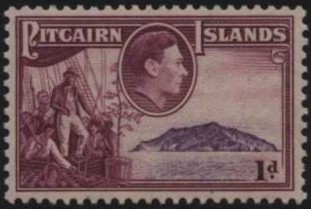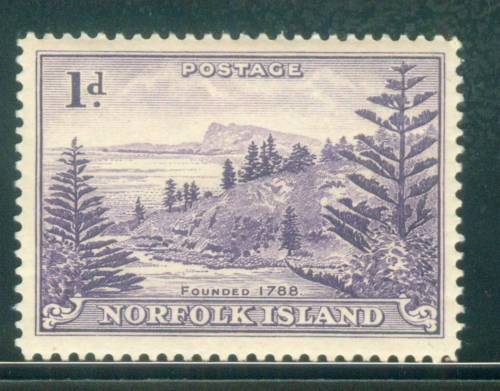
The first letters were send from Pitcairn in 1830. Up to 1926, the text "Posted on Pitcairn Island. No Stamps Available" was printed on the envelopes. From 1927 to 1940, the stamps of New Zealand were used (source: http://www.lareau.org/pitmail.html ). In 1940 the first stamps were issued.

1/2 p green and orange (oranges), 1 p lilac and blue (view of island), 1 1/2 p red and black (John Adams and his house), 2 p brown and green (ship 'Bounty'), 3 p blue and green (map), 4 p green and black (Bounty bible), 6 p grey and brown (ship 'Bounty'), 8 p brown and green (school 1949), 1 Sh grey and lilac (view of island), 2 Sh 6 p brown and green.
For stamps in a similar design, but for another British colony, click here
2 p brown 3 p blue
For stamps in a similar design, but for another British colony, click here
1 1/2 p red (smaller size) 10 Sh lilac
For stamps in a similar design, but for another British colony, click here
2 1/2 p brown 3 p blue 6 p green 1 Sh lilac
For stamps in a similar design, but for other British colonies, click here
4 p green and black
1/2 p lilac and green (cordyline terminalis,
1963?), 1 p green and black (map), 2 p blue and brown (Bounty
bible), 2 1/2 p orange and brown (Pitcairn handycrafts), 3 p blue
and green (Bounty Bay, Pitcairn), 4 p blue and red (Pitcairn
school), 6 p grey and yellow (map, Fiji-Pitcairn connection), 8 p
brown and green (inland scene), 1 Sh brown and black (Pitcairn
handycrafts), 2 Sh orange and black (island wheelbarrow), 2 Sh 6
p (launching new whaleboat).
In 1958 the inscription on the 4 p value was changed to:
'Schoolteachers' house' (the colours and design remained the
same).
4 p black and yellow, 6 p blue and brown, 1 Sh green and orange.
For stamps in a similar design, but for another British colony, click here
2 Sh 6 p blue
For stamps in a similar design, but for another British colony, click here
2 p black and red 2 Sh 6 p blue and red
13 values were issued: 1/2 p, 1 p, 2 p, 3 p, 4 p, 6 p, 8 p ,10 p, 1 Sh, 1 Sh 6 p, 2 Sh 6 p, 4 Sh and 8 Sh.
For stamps in the same design, but for another British colony, click here
1 p orange and violet 2 Sh 6 p blue and green
For stamps in the same design, but for another British colony, click here
1 p blue and brown 1 Sh 6 p violet and green
For stamps in a similar design, but for another British colony, click here
2 p blue, black, gold and red 3 p green, black, gold and red 6 p brown, black, gold and red 1 Sh violet, black, gold and red
For stamps in a similar design, but for other British colonies, click here
4 p lilac, violet, orange and green 2 Sh 6 p lilac, grey, orange and blue
For stamps in a similar design, but for another British colony, click here
8 p green, blue and black 1 Sh 6 p lilac, orange and black
For stamps in a similar design, but for another British colony, click here
1/2 p grey, orange and red 10 p olive, orange and blue 2 Sh lilac, black and orange

1/2 p orange, 1 p violet, 1 1/2 p green, 2 p lilac, 2 1/2 p red, 3 p brown, 3 p green (1959), 4 p lilac, 5 1/2 p blue, 6 p brown, 9 p lilac, 1 Sh green, 2 Sh olive, 2 Sh blue (1959).
3 1/2 p red (tower), 6 1/2 p green (airfield), 7
1/2 p blue (first governors residence), 8 1/2 p brown (barracks
entrance), 10 p lilac (salt house), 5 Sh brown (Bloody bridge).
Surcharged (1958): '7d' on 7 1/2 p blue, '8d' on 8 1/2 p brown.
Surcharged (1960): '1/1' on 7 1/2 p blue, '2/5' on 6 1/2 p green,
'2/8' on 5 Sh brown.
3 p green, 2 Sh lilac; both stamps similar design
5 p.
2 Sh 8 p lilac (local government 1960)